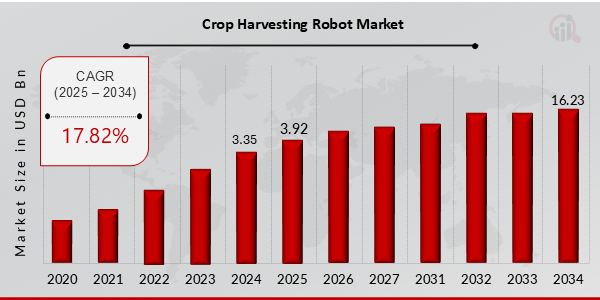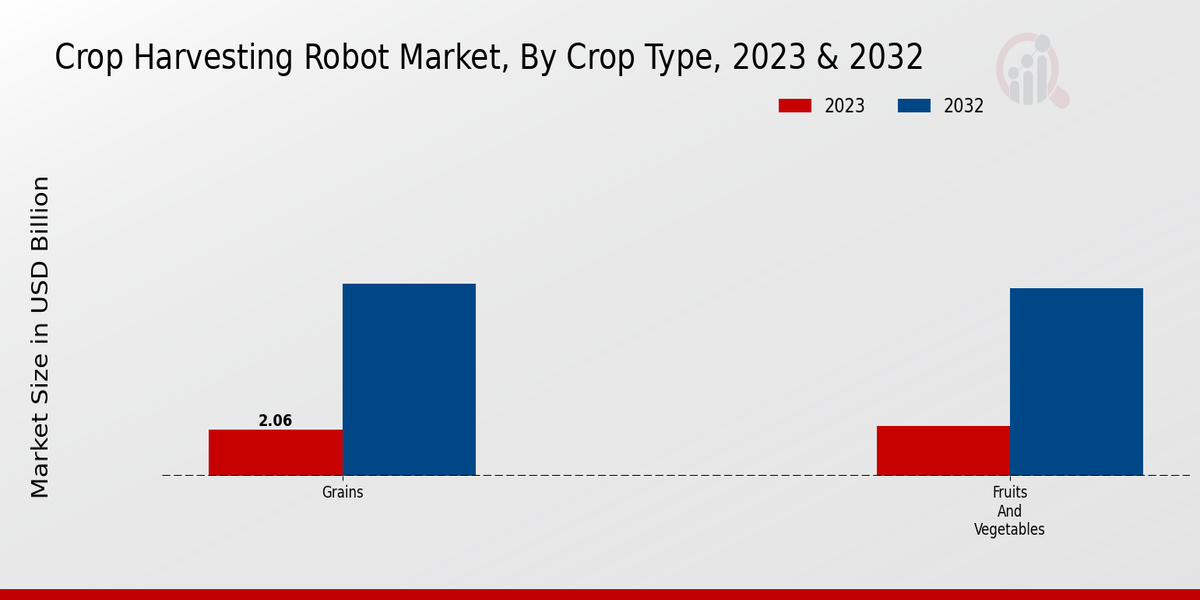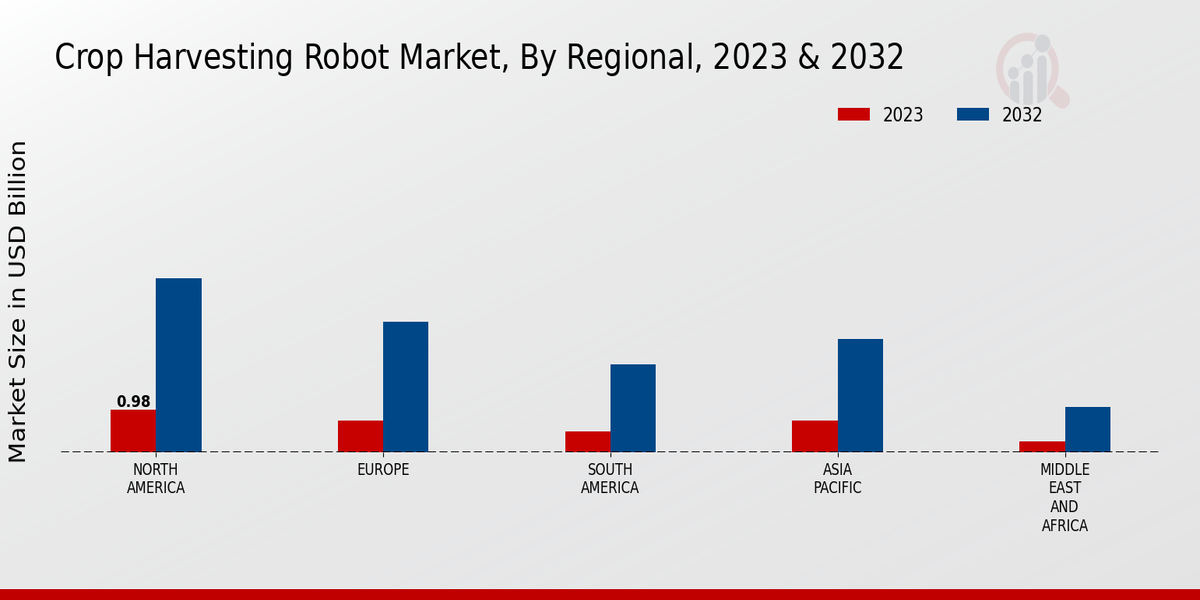Global Crop Harvesting Robot Market Overview:
Crop Harvesting Robot Market Size was estimated at 3.35 (USD Billion) in 2024. The Crop Harvesting Robot Market Industry is expected to grow from 3.92 (USD Billion) in 2025 to 16.23 (USD Billion) till 2034, exhibiting a compound annual growth rate (CAGR) of 17.82% during the forecast period (2025 - 2034).
Key Crop Harvesting Robot Market Trends Highlighted
The Crop Harvesting Robot Market is experiencing significant growth due to the increasing demand for automation and the rising awareness of the benefits of robotic harvesting. Key drivers include the rising need to address labor shortages and improve productivity, coupled with advancements in technology and data analytics.
Opportunities exist in the exploration of new applications for crop harvesting robots, such as terrain adaptation and multi-crop capabilities. The integration of sensors and AI enables more precise, faster harvesting, leading to reduced crop damage and increased yield.Recent trends include the development of autonomous harvesting platforms, the emergence ofaaS models, and the adoption of precision farming techniques. As crop harvesting robots become more efficient and cost-effective, their utilization is likely to expand across various crops and regions, driving further market growth in the coming years.

Source: Primary Research, Secondary Research, MRFR Database and Analyst Review
Crop Harvesting Robot Market Drivers
Technological Advancements Driving Crop Harvesting Robot Market Growth
The Crop Harvesting Robot Market Industry is poised to witness significant growth over the coming years, driven by advancements in technology. These advancements include the development of more efficient and autonomous robots, as well as the integration of artificial intelligence (AI) and machine learning (ML) into these machines. As a result, crop harvesting robots are becoming increasingly capable of performing tasks that were once only possible by human workers.For example, some robots can now identify and harvest ripe crops without damaging them, while others can even sort and pack the crops. These advances are making crop harvesting robots more attractive to farmers, as they can help to reduce labor costs and improve efficiency. In addition to technological advancements, the growing demand for food is also driving the growth of the crop-harvesting robot market. The world's population is expected to reach 9.7 billion by 2050, which will put a strain on the global food supply.Crop harvesting robots can help to meet this demand by increasing the efficiency of crop harvesting and reducing food waste. As a result, the crop harvesting robot market is expected to continue to grow in the coming years as farmers look for ways to improve their efficiency and productivity.
Labor Shortages and Rising Labor Costs
The Crop Harvesting Robot Market Industry is also being driven by labor shortages and rising labor costs. In many parts of the world, there is a shortage of agricultural workers, which makes it difficult for farmers to find the labor they need to harvest their crops. This is leading farmers to turn to crop harvesting robots as a way to fill the labor gap. In addition, rising labor costs are making it more expensive for farmers to hire human workers. This is also leading farmers to invest in crop harvesting robots, as they can help to reduce labor costs.
Government Support for Crop Harvesting Robot Adoption
Governments around the world are also supporting the adoption of crop-harvesting robots. For example, the European Union has launched a number of initiatives to promote the development and adoption of agricultural robotics. These initiatives include providing funding for research and development, as well as offering tax incentives to farmers who invest in crop harvesting robots. As a result of this support, the adoption of crop harvesting robots is expected to accelerate in the coming years.
Crop Harvesting Robot Market Segment Insights:
Crop Harvesting Robot Market Crop Type Insights
In terms of crop type, the Crop Harvesting Robot Market can be segmented into grains, fruits and vegetables, and other crops. Grains accounted for the largest share of the market in 2023, and this trend is expected to continue during the forecast period. The growing demand for grains, such as wheat, rice, and corn, is a major factor driving the growth of this segment. Fruits and vegetables are the second-largest segment of the Crop Harvesting Robot Market. The increasing adoption of precision farming techniques and the rising demand for fresh and organic produce are contributing to the growth of this segment.Other crops, such as cotton, sugarcane, and tobacco, are expected to witness a steady growth rate during the forecast period, owing to the increasing mechanization of harvesting operations in these crops. Overall, the Crop Harvesting Robot Market is expected to witness significant growth, driven by the increasing demand for food and the adoption of advanced technologies in agriculture.

Source: Primary Research, Secondary Research, MRFR Database and Analyst Review
Crop Harvesting Robot Market Autonomy Level Insights
The Crop Harvesting Robot Market is segmented by Autonomy Level into Fully Autonomous, Semi-Autonomous, and Manual. In 2023, the Fully Autonomous segment held the largest market share, accounting for over 45% of the Crop Harvesting Robot Market revenue. The Semi-Autonomous segment is expected to grow at the highest CAGR during the forecast period, driven by the increasing adoption of advanced technologies in the agricultural sector. The Manual segment is expected to decline in market share due to the increasing adoption of autonomous and semi-autonomous harvesting robots.The increasing demand for automation in the agricultural sector is driving the growth of the Crop Harvesting Robot Market. The rising labor costs and the need to improve productivity are also contributing to the market growth. The Fully Autonomous segment is expected to continue to dominate the market due to the advantages of increased efficiency and reduced labor costs. The Semi-Autonomous segment is expected to grow at a significant rate due to the increasing affordability and ease of use of these robots. The Manual segment is expected to decline in market share due to the increasing adoption of autonomous and semi-autonomous harvesting robots.
Crop Harvesting Robot Market Harvesting Method Insights
The Crop Harvesting Robot Market revenue from the Harvesting Method segment was valued at USD 1.23 billion in 2023 and is expected to reach USD 4.92 billion by 2032, exhibiting a CAGR of 16.2% during the forecast period. The growth of this segment can be attributed to the increasing adoption of mechanical harvesting methods, owing to their high efficiency and cost-effectiveness. Mechanical harvesting methods involve the use of specialized machines, such as combine harvesters and grain carts, to harvest crops. These machines are equipped with rotating blades or drums that cut and collect the crop while leaving the straw behind.Mechanical harvesting is particularly suitable for large-scale farming operations, as it allows for quick and efficient harvesting of crops such as wheat, corn, and soybeans. Pneumatic harvesting methods, on the other hand, utilize a stream of air to dislodge and collect the crop from the plant. This method is commonly used for harvesting delicate fruits and vegetables, such as berries, grapes, and tomatoes, as it minimizes damage to the produce. Pneumatic harvesting systems are typically equipped with suction nozzles that gently separate the crop from the plant without causing any bruising or damage.Optical harvesting methods employ sensors and cameras to identify and selectively harvest ripe crops. This method is gaining popularity due to its ability to reduce labor costs and minimize crop losses. Optical harvesting systems use computer vision algorithms to differentiate between ripe and unripe produce, ensuring that only the desired crops are harvested. This method is particularly suitable for harvesting high-value crops, such as fruits and vegetables, where selective harvesting is crucial to maintain quality and maximize profitability.
Crop Harvesting Robot Market Application Insights
The application segment of the Crop Harvesting Robot Market holds significant importance, influencing market growth and revenue generation. Small farms, with their specific needs and constraints, contribute a notable share of the market. In 2023, the revenue generated from small farms stood at approximately USD 0.68 billion. In 2023, large farms accounted for a revenue of approximately USD 0.87 billion. Over the forecast period, this segment is poised to witness steady growth, reaching an estimated USD 3.78 billion in 2032. This growth can be attributed to the increasing adoption of automation and advanced technologies in large-scale farming operations.Fruit orchards and vegetable gardens represent niche segments within the Crop Harvesting Robot Market. In 2023, fruit orchards held a market share of approximately USD 0.34 billion, while vegetable gardens accounted for a share of USD 0.26 billion. These segments are expected to experience steady growth in the coming years, driven by the rising demand for high-quality produce and the need for efficient and cost-effective harvesting solutions.
Crop Harvesting Robot Market Regional Insights
The regional segmentation of the Crop Harvesting Robot Market offers insights into the geographical distribution of market growth. North America held the largest market share in 2023, accounting for around 40% of the global revenue. The region's advanced agricultural practices and high adoption of technology drive its dominance. Europe follows closely, with a market share of approximately 30%. The region's focus on sustainable farming and government support for precision agriculture contributes to its growth. APAC is expected to witness the fastest growth over the forecast period, with a CAGR of 18.5%.The region's expanding agricultural sector and increasing mechanization are key factors fueling its growth. South America and MEA hold relatively smaller market shares, but they are expected to grow steadily in the coming years.

Source: Primary Research, Secondary Research, MRFR Database and Analyst Review
Crop Harvesting Robot Market Key Players And Competitive Insights:
Major players in Crop Harvesting Robot Market industry are investing heavily in research and development to gain a competitive edge. Leading Crop Harvesting Robot Market players are focusing on developing innovative technologies to improve the efficiency and productivity of their robots. The Crop Harvesting Robot Market development is being driven by the increasing demand for automation in the agricultural sector. Competitive Landscape of Crop Harvesting Robot Market is expected to intensify in the coming years as more players enter the market.One of the leading companies in the Crop Harvesting Robot Market is Abundant Robotics. The company is known for its innovative approach to crop harvesting. Abundant Robotics has developed a robotic apple harvester that uses computer vision and machine learning to identify and pick ripe apples. The company's robot is able to harvest apples at a rate of up to 10 times faster than human workers. Abundant Robotics is currently working on developing robotic harvesters for other crops, such as strawberries and tomatoes.Another major player in the Crop Harvesting Robot Market is Agrobot. The company is known for its robotic milking system. Agrobot's robotic milking system uses sensors and cameras to monitor the health and well-being of cows. The system can also automatically milk cows, which frees up farmers to focus on other tasks. Agrobot is currently working on developing robotic milking systems for other animals, such as sheep and goats.
Key Companies in the Crop Harvesting Robot Market Include:
-
SDF Group
-
Deere Company
-
JCB
-
Amazone
-
GEA Group
-
Kubota Corporation
-
Agco Corporation
-
Lely
-
Lemken
-
Einbock
-
Buhler Industries
-
AGCOFendt
-
CNH Industrial
-
Kverneland Group
-
Claas
Crop Harvesting Robot Industry Developments
The Crop Harvesting Robot Market is projected to grow from an estimated USD 2.44 billion in 2023 to USD 10.1 billion by 2032, exhibiting a CAGR of 17.08% during the forecast period. The market is driven by factors such as the increasing demand for automation in agriculture, labor shortages, and the need to improve efficiency and productivity. Key players in the market include AGCO Corporation, CNH Industrial, Deere Company, and Kubota Corporation.Recent news developments in the market include the launch of new products, such as the Autonomous Harvester from AGCO Corporation and the Smart Seeder from CNH Industrial. These products are designed to improve the efficiency and productivity of harvesting operations. In addition, there have been several strategic partnerships and acquisitions in the market, such as the acquisition of Blue River Technology by John Deere in 2017. These developments indicate a strong growth potential for the crop harvesting robot market in the coming years.
Crop Harvesting Robot Market Segmentation Insights
-
Crop Harvesting Robot Market Crop Type Outlook
-
Grains
-
Fruits and Vegetables
-
Other Crops
-
Crop Harvesting Robot Market Autonomy Level Outlook
-
Fully Autonomous
-
Semi-Autonomous
-
Manual
-
Crop Harvesting Robot Market Harvesting Method Outlook
-
Mechanical
-
Pneumatic
-
Optical
-
Crop Harvesting Robot Market Application Outlook
-
Small Farms
-
Large Farms
-
Fruit Orchards
-
Vegetable Gardens
-
Crop Harvesting Robot Market Regional Outlook
-
North America
-
Europe
-
South America
-
Asia-Pacific
-
Middle East and Africa
| Report Attribute/Metric |
Details |
|
Market Size 2024
|
USD 3.35 Billion
|
|
Market Size 2025
|
USD 3.92 Billion
|
|
Market Size 2034
|
USD 16.23 Billion
|
|
Compound Annual Growth Rate (CAGR)
|
17.82% (2025-2034)
|
| Report Coverage |
Revenue Forecast, Competitive Landscape, Growth Factors, and Trends |
|
Base Year
|
2024
|
|
Market Forecast Period
|
2025-2034
|
|
Historical Data
|
2020-2023
|
| Market Forecast Units |
USD Billion |
| Key Companies Profiled |
SDF Group, Deere Company, JCB, Amazone, GEA Group, Kubota Corporation, Agco Corporation, Lely, Lemken, Einbock, Buhler Industries, AGCOFendt, CNH Industrial, Kverneland Group, Claas |
| Segments Covered |
Crop Type, Autonomy Level, Harvesting Method, Application, Regional |
| Key Market Opportunities |
Increased efficiency Reduced labor costs Improved crop quality Enhanced adaptability Advanced technology. |
| Key Market Dynamics |
Rising demand for automation, labor shortage, government support, technological advancements, & increasing farm size. |
| Countries Covered |
North America, Europe, APAC, South America, MEA |
Frequently Asked Questions (FAQ) :
The Crop Harvesting Robot Market is projected to expand at a CAGR of 17.82% from 2025 to 2034.
Rising labor costs, growing demand for production, and government initiatives to promote agricultural automation are among the primary factors fueling the expansion of the Crop Harvesting Robot Market.
The grain harvesting segment is projected to register the highest growth rate in the Crop Harvesting Robot Market from 2024 to 2032, driven by the increasing demand for automated solutions for harvesting grains such as wheat, corn, and rice.
Key players in the Crop Harvesting Robot Market include Deere Company, AGCO Corporation, CNH Industrial, Kubota Corporation, and Yanmar Holdings.

















